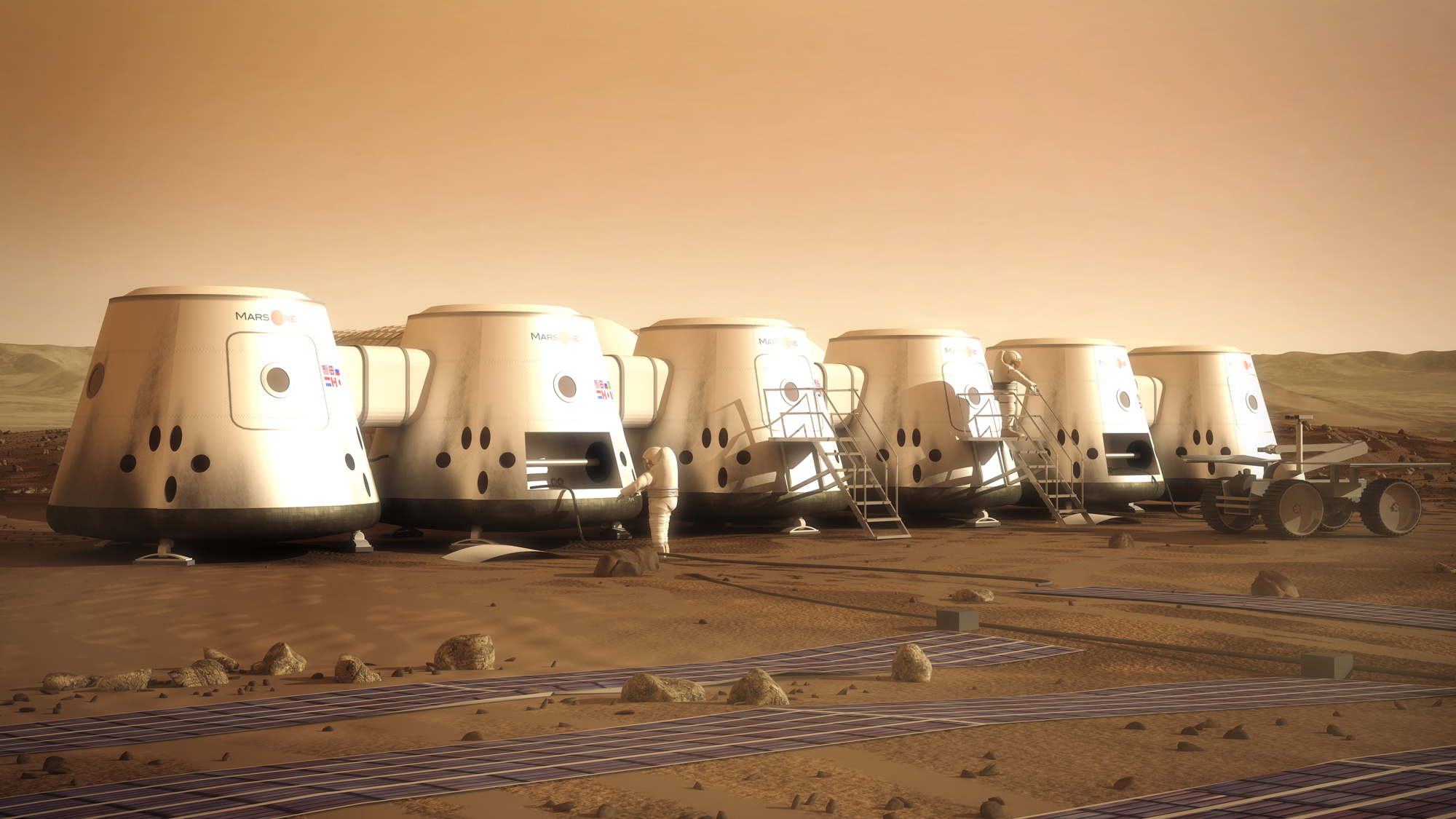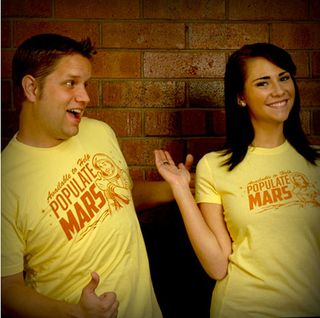Private Mars Colony Project Undaunted by Application Shortfall

A private Mars colonization effort has fallen far short of its expected number of astronaut applications but still aims to put boots on the Red Planet in 2023.
With just a few days left in the application process, the nonprofit Mars One Foundation has received about 165,000 submissions from prospective Mars colonists — a far cry from the 1 million that officials had originally targeted in April before opening the process.
The shortfall could affect Mars One's planning and progress, since the foundation is using application fees to fund its activities in these early days. But Mars One intends to pay most of its bills by staging a global media event around the colonization effort, and officials expressed confidence that interest in such a spectacle will still be high. [The Mars One Colony Project (Images)]
"The 165,000 applicants that we have so far is still, a very, very large number, and the TV people that we talk to — we have two very serious discussions going on with consortia of investors that include media," Mars One co-founder and CEO Bas Lansdorp told SPACE.com last week.
Lots of applications
Mars One aims to land four people on the Red Planet in April 2023 at a cost of about $6 billion. Supply ships and four additional colonists will launch every two years thereafter to grow the Mars colony. At the moment, there is no plan to bring any of these explorers back to Earth.
Twenty-four colonists will be selected by mid-2015 for the first six colony flights. After the initial 2023 flight, each colonist trip will cost $4 billion and the regular supply ship missions will be about $250 million each, foundation officials have said.
Get the Space.com Newsletter
Breaking space news, the latest updates on rocket launches, skywatching events and more!
Mars One opened its application process for potential colonists on April 22 of this year and set a deadline of Aug. 31. Applicants have to pay a fee, which ranges from $5 to $75 depending on which country they live in. The fee for United States citizens is $38.
On April 10, Lansdorp told SPACE.com that Mars One expected to get 1 million applications. By mid-April, the foundation had 45,000 people registered for its mailing list and had received 10,000 emails from individuals. By early May, two weeks after applications opened, Mars One was claiming 78,000 applicants.
At the time, Lansdorp said in a statement: "These numbers put us right on track for our goal of half a million applicants," lowering the applications bar he had set a few weeks earlier.
By Aug. 22, Mars One had received about 165,000 applications, meaning the foundation could have a total of around 200,000 in hand by the Aug. 31 deadline. Lansdorp told SPACE.com on Aug. 23 that potential applicants should not be concerned about any perceived lack of qualifications: "We have the feeling that people feel that, 'If I’m not a pilot or I don’t have astronaut training already, how can I ever be qualified to go to Mars?' And actually, the opposite is true."

The average application fee is about $25, Lansdorp said, so 200,000 submissions would bring in about $5 million. That would leave Mars One $20 million short of what it would have gotten from 1 million applications (and $7.5 million shy of the $12.5 million that 500,000 applications would have brought in).
However, Lansdorp also told SPACE.com last week that the 165,000 included those that had not paid. He declined to say how much revenue applications had generated.
Funding the mission
Mars One may use proceeds from application fees to cover a variety of activities over the next two years, including the basic running costs of the organization and its website; selecting candidates from hundreds of thousands of applicants; managing its 2016 Mars robotic demonstration mission; building the mock Mars base that candidates will train in here on Earth; and paying for the initial development work for all the human spaceflight-related technologies the 2023 mission will need.
Mars One may be able to share technology development costs with American millionaire and original space tourist Dennis Tito’s Inspiration Mars mission. Announced in February, Inspiration Mars aims to send a two-person crew on a Mars flyby in 2018.
"I met Dennis Tito...and there are definitely areas where we can co-operate on the technology," Lansdorp said. "They will fly to Mars and back, and we will fly there...so there is definitely going to be technical cooperation." [Inspiration Mars: Private Mars Voyage in 2018 (Gallery)]
Inspiration Mars and Mars One already share a supplier in Paragon Space Development Corp. Mars One announced in March that Paragon will study life support and spacesuit systems for the colonization effort.
Lansdorp also said on Aug. 23 that Mars One will make an announcement soon about its 2016 robotic demonstration mission. The foundation is working on all the requirements documents with its potential suppliers so it can award contracts for this mission, which will send into Martian orbit a communication satellite capable of relaying images, videos and other data from the Red Planet's surface and test technologies needed for human spaceflight.
However, some space engineering companies may not want to be paid in bitcoin. Lansdorp confirmed on Aug. 23 that Mars One is accepting the digital currency bitcoin. The foundation is offering bitcoin as an option to applicants because banking services such as Paypal are not available in every country, Lansdorp explained.
"Literally in any country in the world, you can use bitcoin to pay," he said. "It is a little bit more complex than Paypal, but if you really want this [to go to Mars], you should be able to use bitcoin."
As well as generating revenue, the number of fee-paying applicants can convince broadcasters that there will be an audience for a Mars One television program, Lansdorp said.
He points to the $4 billion generated by televising the three-week-long 2012 London Olympics as an example of how an ongoing worldwide media event can produce the enormous revenues Mars One needs. The foundation’s advisors and ambassadors include one of the co-creators of the Big Brother television show and a television producer in the United Kingdom with experience in various entertainment shows.
"They are very, very impressed with the amount of feedback we are getting and...especially with our limited brand awareness, because if you ask people in the street in the U.K. or U.S., we have a brand awareness of 5-10 per cent," Lansdorp said of his potential media partners, "So with that in mind, they are extremely impressed with the people who are signing up and showing interest.”
Lansdorp was insistent that there will be TV programs, “because we want the world to be involved in this adventure...We’re still under discussions with a number of parties on that so it could be an open thing, or it could be an exclusive thing where it's one broadcaster per country.”
Mars One has several other revenue sources, including "silver sponsors" that advertise on the website, of which there are seven; its 22 contributors providing funds and in-kind services; Mars One-branded merchandise sales through the website; its Youtube channel hosting promotional videos; and crowdfunding.
The foundation also has a 50/50 revenue-sharing agreement with Dutch audiovisual production company Tetteroo Media, which produced the pay-per-view independent documentary "One Way Astronaut."
Lansdorp said he doesn't know how many people had paid the $2.95 to watch the documentary to date. In a phone call to Tetteroo Media on Monday (Aug. 26), the production company declined to say how many people had viewed the film. [Watch the film trailer for 'One Way Astronaut']
While Lansdorp declined to disclose how many hits Mars One's we
bsite is getting, he told SPACE.com that the number is very attractive to potential sponsors.
Meanwhile, crowdfunding is a work in progress, Lansdorp said.
"That is one of things we’re preparing right now, and not just because of the funds, but also because this is mankind’s missions to Mars, and crowdfunding is one of the nicest ways to add people and really involve them in what you are doing, and that is very high on our things-to-do list," he said.
More opportunities to apply
Mars One will have more opportunities in the future to get application fees to help support its activities. The foundation plans to restart the application process after July 2015 to find 12 new people every year. Some of the 24 astronauts in the class of 2015 are expected to drop out, officials explained, and the colonization efffort needs to grow a steady supply of potential settlers.
The Mars One website states that after this year’s Aug. 31 deadline, the next stage, round two, will require candidates to undergo an interview with a selection committee and have a physician confirm they are in good health.
Those selected will join 20 to 40 others in their part of the world for regional selection rounds, which Mars One’s website states "could be broadcasted on TV and internet in countries around the world" and will involve "challenges that demonstrate their suitability to become one of the first humans on Mars."
On Aug. 23, Lansdorp described the television aspect of this stage as "much more comparable to an election, a presidential election, where people decide who are our ambassadors to the red planet are,"than a reality show.
The final fourth round, which will also be televised, will involve the Mars One selection committee creating international teams from the regional winners. Those groups will be expected to work together and demonstrate an ability to survive harsh conditions. The winners of that challenge will start training in 2015 as six teams of four for the 2023 Mars mission.
Follow us @Spacedotcom, Facebook or Google+. Originally published on SPACE.com.
Join our Space Forums to keep talking space on the latest missions, night sky and more! And if you have a news tip, correction or comment, let us know at: community@space.com.
Rob Coppinger is a veteran aerospace writer whose work has appeared in Flight International, on the BBC, in The Engineer, Live Science, the Aviation Week Network and other publications. He has covered a wide range of subjects from aviation and aerospace technology to space exploration, information technology and engineering. In September 2021, Rob became the editor of SpaceFlight Magazine, a publication by the British Interplanetary Society. He is based in France. You can follow Rob's latest space project via Twitter.










